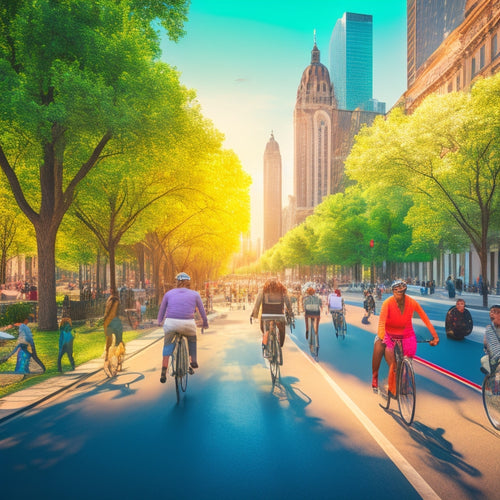
5 Best Urban Mobility Solutions for a Greener City
Share
You're looking to enhance your city into a greener, more sustainable hub. Adopting cutting-edge urban mobility solutions can help. To start, invest in electric vehicle charging infrastructure, aiming for 14 million public charging points by 2030. Next, electrify 30% of public transportation fleets by 2025 and promote bike-friendly urban planning. Autonomous shuttle services can also enhance travel experiences while reducing congestion. Finally, smart traffic management systems can optimize traffic flow. Explore these five solutions further to reveal a more environmentally friendly urban landscape, and discover the innovative strategies that can future-proof your city's transportation system.
Key Takeaways
• Develop electric vehicle charging infrastructure to support widespread adoption and reduce emissions.
• Electrify public transportation fleets and promote sustainable options to minimize carbon footprint.
• Design bike-friendly cities with dedicated lanes, cycling corridors, and smart traffic management for efficient travel.
• Integrate autonomous shuttle services to enhance travel experience, reduce congestion, and lower emissions.
• Implement smart traffic management systems with real-time data to optimize traffic flow and reduce congestion.
Electric Vehicle Charging Infrastructure
As you get ready to shift your fleet to electric vehicles, you'll need to make sure that your city's infrastructure can support the increased demand for charging stations, with the International Energy Agency estimating that 14 million public charging points will be required globally by 2030. This means you'll need to assess your grid capacity to confirm it can handle the added load. You'll want to identify areas where the grid is already strained and prioritize upgrades to prevent brownouts or blackouts.
A key consideration will be the type of charging stations you install. Level 2 charging stations, which use 240-volt charging, can deliver up to 25 miles of range per hour of charging. DC Fast Chargers, on the other hand, can provide up to 100 miles of range in just 30 minutes.
As you plan your charging infrastructure, you'll need to balance the need for fast and convenient charging with the strain it puts on the grid. By taking a thoughtful and strategic approach, you can ensure a seamless shift to electric vehicles and a more sustainable future for your city.
Green Public Transportation Systems
By 2025, cities like yours will need to electrify at least 30% of their public transportation fleets to meet emerging emissions standards, making green public transportation systems a critical component of your urban mobility strategy. You'll need to prioritize sustainable options to reduce your city's carbon footprint.
Biofuels implementation is one viable solution, offering a cleaner alternative to traditional fossil fuels. By incorporating biofuels into your public transportation system, you can notably decrease greenhouse gas emissions and improve air quality.
To further incentivize eco-friendly transportation, consider introducing carpool incentives. By offering rewards or discounts to passengers who carpool, you can reduce the number of single-occupancy vehicles on the road, decreasing congestion and emissions.
Additionally, investing in green public transportation systems can have a positive impact on your city's economy, creating jobs and stimulating local growth. By embracing innovative, sustainable solutions, you can create a healthier, more sustainable urban environment for your citizens.
As you develop your urban mobility strategy, prioritize green public transportation systems to create a better future for your city.
Bike-Friendly Urban Planning Design
You'll need to rethink urban planning design to prioritize bike-friendly infrastructure, allocating at least 10% of your city's roadway network to dedicated bike lanes and pedestrianized zones to meet growing demands for sustainable transportation. This shift won't only reduce carbon emissions but also enhance air quality, reduce traffic congestion, and promote a healthier lifestyle for citizens.
To achieve this, consider the following strategies:
-
Designate cycling corridors: Identify primary routes for cyclists, ensuring a direct, efficient, and safe journey through the city.
-
Develop bike boulevards: Convert low-traffic streets into bike-friendly zones, incorporating traffic calming measures and ample bike parking.
-
Implement smart traffic management: Integrate intelligent transportation systems to optimize traffic flow, reducing congestion and promoting a seamless cycling experience.
Autonomous Shuttle Services Integration
With over 80% of urban residents willing to use autonomous transportation, integrating autonomous shuttle services into your urban mobility network can greatly enhance the overall travel experience, reduce congestion, and lower emissions. By leveraging autonomous shuttles, you can provide efficient, reliable, and environmentally friendly transportation options for your citizens.
| Benefits | Advantages |
|---|---|
| Safety Protocols | Enhanced safety features, reduced accidents |
| Rural Accessibility | Increased mobility for rural residents, bridging the urban-rural divide |
| Environmental Impact | Reduced emissions, decreased air pollution |
As you integrate autonomous shuttle services, consider implementing robust Safety Protocols, ensuring the utmost safety for passengers. Moreover, autonomous shuttles can greatly improve Rural Accessibility, providing equal access to transportation for all residents. By embracing this innovative solution, you'll not only enhance the urban mobility experience but also contribute to a greener, more sustainable city.
Smart Traffic Management Systems
Optimizing traffic flow and reducing congestion require implementing Smart Traffic Management Systems that leverage real-time data and advanced analytics to synchronize traffic signals and traffic routing. As you navigate through urban streets, you'll appreciate the benefits of a system that dynamically adjusts to changing traffic patterns, minimizing congestion and reducing travel times.
Here are three key benefits of Smart Traffic Management Systems:
-
Real-time traffic monitoring: Get instant insights into traffic conditions, enabling data-driven decisions to optimize traffic flow.
-
Dynamic traffic signal control: Adjust signal timings in real-time to prioritize traffic flow, reducing congestion and decreasing travel times.
-
Congestion pricing integration: Implement dynamic pricing strategies to discourage travel during peak hours, reducing congestion and encouraging alternative modes of transport.
Frequently Asked Questions
How Can Urban Mobility Solutions Address Social Equity and Accessibility Concerns?
As you design urban mobility solutions, you'll need to tackle transportation disparities by investing in pedestrian infrastructure, ensuring equal access to safe, walkable environments, and bridging gaps in underserved communities.
What Role Do Government Policies Play in Encouraging Green Urban Mobility Adoption?
As you navigate the complex web of urban mobility, you'll find government policies play a pivotal role in encouraging green adoption, crafting regulatory frameworks that foster innovation and implementing incentive structures that drive behavioral change.
Can Urban Mobility Solutions Be Effectively Implemented in Low-Density Cities?
As you navigate low-density cities, you'll face Rural Challenges like sparse populations and limited transit options, as well as Suburban Barriers like sprawling development and inadequate infrastructure, making effective urban mobility solutions a complex, data-driven puzzle to solve.
How Do Urban Mobility Solutions Impact Local Businesses and Urban Economies?
"When you're stuck between a rock and a hard place, urban mobility solutions can be the game-changer, boosting Economic Growth and sparking Business Revitalization, as efficient transportation systems attract new customers, increasing foot traffic and sales for local businesses."
What Is the Potential for Urban Mobility Solutions to Reduce Urban Sprawl?
As you explore urban mobility solutions, you'll find compact development and green belts can reduce urban sprawl by 30%, preserving natural habitats and promoting sustainable growth, while increasing property values by 15%.
Related Posts
-

Why Go Green With Automotive Products Online?
By switching to eco-friendly automotive products online, you're taking a significant step towards reducing your carbo...
-

What Makes a Road Bike-Friendly by Design?
As you plan and design roads, incorporating features like dedicated bike lanes, smooth surfaces, and traffic calming ...
-

What Are the Average Cost Savings of Solar Panels
You can expect to save between $400 and $1,000 per year on your electricity bills with solar panels, which translates...


